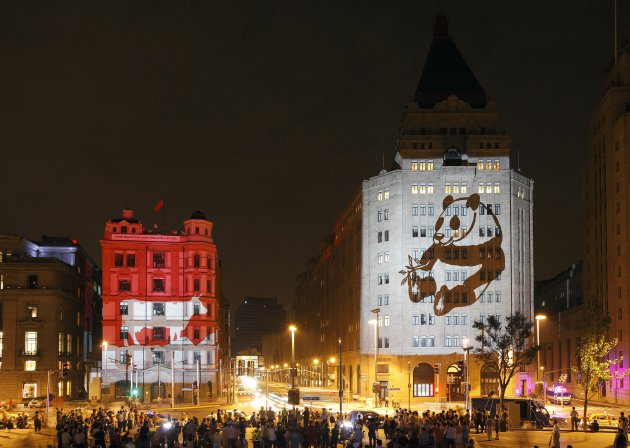art talk: Gerry Hofstetter Lights Up

Last month, Swiss artist Gerry Hofstetter lit up the Lupu bridge and several buildings on the Bund as part of a celebration of Sino-Swiss ties arranged by the Swiss Pavilion. Both projections were carefully planned, but the bridge was especially complex.
“This is already art, to get to the locations, and to organise these things is already art, and to have permission, this is an art,” Hofstetter says. He has thick, dark eyebrows and curly hair that’s white at the temples. He wears a crimson cheongsam and a cheeky grin that suggests he thinks he’s getting away with something, that he’s on the make, even after 11 years creating these illuminations.
Three boats, including Hofstetter’s own catamaran, and a total of seven modified theatre projectors worked together to light up 700 metres of the Lupu bridge. “The big boat stands,” Hofstetter smacks his hands together, “nailed down in the water against the wind, against the current, no problem. The other two boats, single body boats, old ones, were hard to navigate,” he says.
“And then you have the street lights,” he continues. “They turned off all the lights on the bridge, but they left on the street lamps,” which, along with Shanghai’s general light pollution, competed with the projections. “Then you have the humidity; it was raining the whole day so the VIPs didn’t see very well, but for us on the boats, phwoar, it was burning.”
The Swiss and Chinese icons that were projected – Chinese stars, Swiss crosses, pandas, cows – in Shanghai were unsurprising and on message, as Expo-affiliated art usually is, but Hofstetter’s solo show at Galerie Junger features more intriguing works of even greater logistical complexity. The artist has travelled to the Arctic four times and to Antarctica twice to project images onto icebergs, returning with some truly startling images.
One of the strangest is a grand staircase, erected entirely out of context, which curves up and out of the ocean, as if left for water spirits or the ghosts of Titanic victims. Other images work so well with their natural canvases that the icescape all but disappears. Long shadows of camels in an orange desert are especially deceptive. “With the camels people say, wow, you’ve been to the desert,” Hofstetter says. “I say, have a closer look.”















Recent comments
3 weeks 2 days ago
4 weeks 6 days ago
5 weeks 1 day ago
5 weeks 1 day ago
5 weeks 3 days ago
5 weeks 3 days ago
9 weeks 4 hours ago
9 weeks 6 days ago
10 weeks 1 day ago
10 weeks 6 days ago